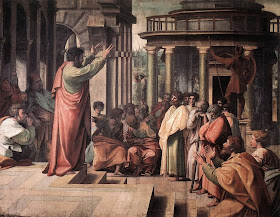 |
| St. Paul Preaching in Athens - Raffaello Raphael Sanzio |
Paul’s Missionary Tube Map
 |
| http://www.foundationsforfreedom.net/References/NT/Acts/Acts_Map_1-2_Journey.html |
 |
| http://www.foundationsforfreedom.net/References/NT/Acts/Acts_Map_3-Rome_Journeys.html |



Paul’s First Missionary Journey through Perga and Pisidian Antioch
After sailing from Cyprus to the Turkish coast, Paul and Barnabas visit the city of Perga before traveling to Pisidian Antioch and other cities on the Anatolian interior. When they head back to the coast, the travelers followed the same route. Why did they choose such a treacherous route for Paul’s first missionary journey? Mark R. Fairchild explores unexcavated sites along the Kestros River Valley, exposing evidence of Jewish populations en route. Acts indicates that Paul deliberately traveled to cities with Jewish populations. Perga was a major city, and the presence of a Jewish community there made it an ideal base for Paul’s first missionary journey through Anatolia. Fairchild argues that Paul and Barnabas could have taken an easy, but roundabout, path along established Roman roads, but opted to travel along the rugged Kestros Valley because of the hospitality of local Jewish communities (see Perga Maps 1 and 2 below):
 |
| Paul and Barnabas would have sailed from Cyprus to one of these ports on the Turkish coast before traveling to Perga. BAS |
 |
| Mark R. Fairchild suggests that Paul traveled from Perga up the Kestros River Valley to Pisidian Antioch, the route indicated in green. BAS |
SAMPLE CHRONOLOGIES AND CHARTS
click on any chart to enlarge






Absolutely terrific information! I was wanting to figure out the routes Paul traveled and your diagrams have really helped me! Thanks!
ReplyDeleteThank you Katherine. :)
ReplyDeleteon the 6th chart i notice under pt 1 that is says no record of virgin birth, no empty tomb and "all derive from Paul". Is isthatto mean we hav no records of empty tomb prior to the gospels? That the first 40 years are connected to Paul? Where do we find the modern names of the places Paul visited? Thanks for all yo have done here, it is very helpful
ReplyDelete@ Dale: "No Virgin Birth, No empty tomb" in Paul does not deny either but seems not to be the early church's focus until later as further proofs of Jesus' divinity were required in presenting the gospel message to pagan/superstitious/mythic thinking cultures than extant. However Paul does mention the resurrection of Christ quite a bit in his writings and also describes Jesus' holiness/substance/majesty as Divine and separate from humanity in one sense, but in another sense uniquely identified with humanity. As the early church matured the "Creeds of Chalcedone" dealing with the "two natures in one" of Christ ("Hupostasis") would later develope several hundred years afterwards. Regards the modernized names of Paul's journeys many have been Anglicized over the years and retained but in the native tongues of each area carry non-English forms for the churches in place in those regions. I could not find a contemporary map of these native forms but if you locate one or two please share the links with us. Thanks.
ReplyDelete